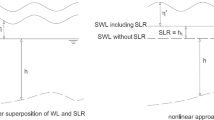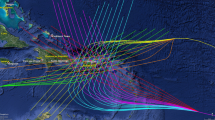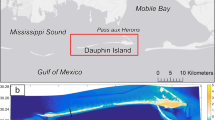Abstract
Two linear methods, including the simple linear addition and linear addition by expansion, and numerical simulations were employed to estimate storm surges and associated flooding caused by Hurricane Andrew for scenarios of sea level rise (SLR) from 0.15 m to 1.05 m with an interval of 0.15 m. The interaction between storm surge and SLR is almost linear at the open Atlantic Ocean outside Biscayne Bay, with slight reduction in peak storm surge heights as sea level rises. The nonlinear interaction between storm surges and SLR is weak in Biscayne Bay, leading to small differences in peak storm surge heights estimated by three methods. Therefore, it is appropriate to estimate elevated storm surges caused by SLR in these areas by adding the SLR magnitude to storm surge heights. However, the magnitude and extent of inundation at the mainland area by Biscayne Bay estimated by numerical simulations are, respectively, 22–24 % and 16–30 % larger on average than those generated by the linear addition by expansion and the simple linear addition methods, indicating a strong nonlinear interaction between storm surge and SLR. The population and property affected by the storm surge inundation estimated by numerical simulations differ up to 50–140 % from that estimated by two linear addition methods. Therefore, it is inappropriate to estimate the exacerbated magnitude and extent of storm surge flooding and affected population and property caused by SLR by using the linear addition methods. The strong nonlinear interaction between surge flooding and SLR at a specific location occurs at the initial stage of SLR when the water depth under an elevated sea level is less than 0.7 m, while the interaction becomes linear as the depth exceeds 0.7 m.




Similar content being viewed by others
Explore related subjects
Discover the latest articles and news from researchers in related subjects, suggested using machine learning.References
Bindoff NL, Willebrand J, Artale V, Cazenave A, Gregory J, Gulev S, Hanawa K, Le Quéré C, Levitus S, Nojiri Y, Shum CK, Talley LD, Unnikrishnan A (2007) Observations: oceanic climate change and sea level. In: Solomon S, Qin D, Manning M, Chen Z, Marquis M, Averyt KB, Tignor M, Miller HL (eds) Climate change 2007: the physical science basis. Contribution of working group I to the fourth assessment report of the intergovernmental panel on climate change. Cambridge University Press, Cambridge
Davis RA (1997) Geology of the Florida coast. In: Randazzo AF, Jones DS (eds) The geology of Florida. University Press of Florida, Miami, pp 155–168
De Ronde JG (1993) What will happen to The Netherlands if sea-level rise accelerates? Climate and sea level change: observations, projections and implications 322–335
Douglas BC (2001) Sea level change in the era of the recording tide gauge. In: Douglas BC, Kearney MS, Leatherman SP (eds) Sea level rise: history and consequences. Academic, San Diego, pp 37–64
Finkl CW, Warner MT (2005) Morphologic features and morphodynamic zones along the inner continental shelf of southeastern Florida: an example of form and process controlled by lithology. J Coast Res 79–96
Flather R, Williams J (2000) Climate change effects on storm surges: methodologies and results. Climate scenarios for water-related and coastal impacts 66–72
Frazier TG, Wood N, Yarnal B, Bauer DH (2010) Influence of potential sea level rise on societal vulnerability to hurricane storm-surge hazards, Sarasota County, Florida. Appl Geogr 30:490–505
Hallegatte S, Ranger N, Mestre O, Dumas P, Corfee-Morlot J, Herweijer C, Wood RM (2011) Assessing climate change impacts, sea level rise and storm surge risk in port cities: a case study on Copenhagen. Clim Chang 104:113–137
Jelesnianski CP, Chen J, Shaffer WA (1992) SLOSH: sea, lake and overland surges from hurricanes. Technical report NWS 48. NOAA, Washington, p 71
Katsman CA, Sterl A, Beersma J, van den Brink H, Church J, Hazeleger W, Kopp R, Kroon D, Kwadijk J, Lammersen R (2011) Exploring high-end scenarios for local sea level rise to develop flood protection strategies for a low-lying delta—the Netherlands as an example. Clim Chang 109:617–645
Kirshen P, Knee K, Ruth M (2008) Climate change and coastal flooding in Metro Boston: impacts and adaptation strategies. Clim Chang 90:453–473
Kleinosky LR, Yarnal B, Fisher A (2007) Vulnerability of Hampton Roads, Virginia to storm-surge flooding and sea-level rise. Nat Hazard 40:43–70
Lin N, Emanuel K, Oppenheimer M, Vanmarcke E (2012) Physically based assessment of hurricane surge threat under climate change. Nat Clim Chang 2:462–467
Lowe JA, Gregory J (2005) The effects of climate change on storm surges around the United Kingdom. Phil Trans R Soc A Math Phys Eng Sci 363:1313–1328
Lowe J, Gregory J, Flather R (2001) Changes in the occurrence of storm surges around the United Kingdom under a future climate scenario using a dynamic storm surge model driven by the Hadley Centre climate models. Clim Dyn 18:179–188
Mattocks C, Forbes C (2008) A real-time, event-triggered storm surge forecasting system for the state of North Carolina. Ocean Model 25:95–119
McInnes KL, Walsh JE, Hubbert GD, Beer T (2003) Impact of sea-level rise and storm surges on a coastal community. Nat Hazard 30:187–207
McInnes KL, Macadam I, Hubbert GD, O’Grady JG (2009) A modelling approach for estimating the frequency of sea level extremes and the impact of climate change in southeast Australia. Nat Hazard 51:115–137
McInnes KL, Macadam I, Hubbert G, O’Grady J (2011) An assessment of current and future vulnerability to coastal inundation due to sea level extremes in Victoria, southeast Australia. Int J Climatol
Mousavi ME, Irish JL, Frey AE, Olivera F, Edge BL (2011) Global warming and hurricanes: the potential impact of hurricane intensification and sea level rise on coastal flooding. Clim Chang 104:575–597
National Research Council (1987) Responding to changes in sea level: engineering implications. National Academy Press, Washington
Powell MD, Houston SH, Amat LR, Morisseau-Leroy N (1998) The HRD real-time hurricane wind analysis program. J Wind Eng Ind Aerodyn 77&78:53–64
Powell MD, Uhlhorn EW, Kepert JD (2009) Estimating maximum surface winds from hurricane reconnaissance measurements. Weather Forecast 24:868–883
Pugh DT (1996) Tides, surges and mean sea-level (reprinted with corrections). John Wiley & Sons Ltd
Rahmstorf S (2007) A semi-empirical approach to projecting future sea-level rise. Science 315:368–370
Sella GF, Stein S, Dixon TH, Craymer M, James TS, Mazzotti S, Dokka RK (2007) Observation of glacial isostatic adjustment in “stable” North America with GPS. Geophys Res Lett 34:L02306–L02307
Shepard CC, Agostini VN, Gilmer B, Allen T, Stone J, Brooks W, Beck MW (2011) Assessing future risk: quantifying the effects of sea level rise on storm surge risk for the southern shores of Long Island, New York. Nat Hazards 1–19
Smith JMK, Cialone MA, Wamsley TV, McAlpin TO (2010) Potential impact of sea level rise on coastal surges in southeast Louisiana. Ocean Eng 37:37–47
Tebaldi C, Strauss BH, Zervas CE (2012) Modelling sea level rise impacts on storm surges along US coasts. Environ Res Lett 7:014032
U.S. Army Corps of Engineers (2011) Sea-level change considerations for civil works programs. EC 1165-2-212, p. 32
Vermeer M, Rahmstorf S (2009) Global sea level linked to global temperature. Proc Natl Acad Sci 106:21527–21532
Wu SY, Yarnal B, Fisher A (2002) Vulnerability of coastal communities to sea level rise: a case study of Cape May County, New Jersey, USA. Clim Res 22:255–270
Zhang K (2011) Analysis of non-linear inundation from sea-level rise using LIDAR data: a case study for South Florida. Clim Chang 106:537–565
Zhang K, Douglas BC, Leatherman SP (2004) Global warming and coastal erosion. Clim Chang 64:41–58
Zhang K, Xiao C, Shen J (2008) Comparison of the CEST and SLOSH models for storm surge flooding. J Coast Res 24:489–499
Zhang K, Liu H, Li Y, Xu H, Shen J, Rhome J, Smith TJ III (2012) The role of mangroves in attenuating storm surges. Estuarine Coastal Shelf Sci 102–103:11–23
Acknowledgments
We would like to thank Mr. Mac Sisson at Virginia Institute of Marine Science for reviewing the manuscript. We would also like to thank three anonymous reviewers for their valuable comments and suggestions. This work is funded under a grant from the Coastal and Ocean Climate Applications Program of the NOAA Climate Program Office. The views expressed represent those of the authors and do not necessarily reflect the views or policies of NOAA.
Author information
Authors and Affiliations
Corresponding author
Rights and permissions
About this article
Cite this article
Zhang, K., Li, Y., Liu, H. et al. Comparison of three methods for estimating the sea level rise effect on storm surge flooding. Climatic Change 118, 487–500 (2013). https://doi.org/10.1007/s10584-012-0645-8
Received:
Accepted:
Published:
Issue Date:
DOI: https://doi.org/10.1007/s10584-012-0645-8




